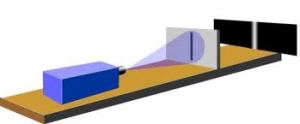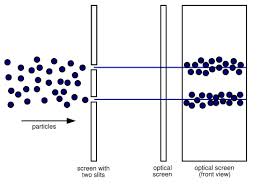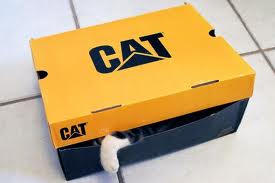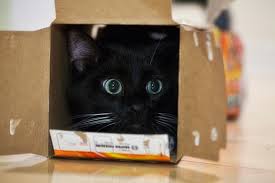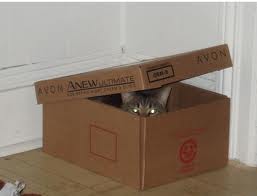Everybody loves the phrase, most don’t understand it. Some of us find the greatest humor in those that don’t know that they don’t understand it.
I find the best way to explain quantum physics is to use a blackboard. If you don’t know what a blackboard is, imagine a whiteboard that is black. If you don’t know what “imagine” means, you’re on the wrong blog. This is largely the reason that many people do not understand quantum physics, they don’t know how to imagine.
Begin, if you will, with the concept of “duality”. If you need help with that think of Batman. Now think of Bruce Wayne. Are they the same person? Now, as you are defining “same” in your mind, you understand the need for a blackboard. Pictures and videos are great tools, and a whiteboard is a poor substitute, but a blackboard is the very best tool. Time to stop whining, sorry, back to Erwin’s fondness for cats.
 Erwin Schrodinger at the blackboard
Erwin Schrodinger at the blackboard
Dr. Schrodinger served in the Army Artillery in WW1, and despite (or due to, there’s that duality again) the horror of war continued publishing his work in physics. Imagine rats in the trenches of WW1. Kind of explains something, doesn’t it? When WW2 came along Erwin was back in Germany, but as a Catholic he was able to see the horrors of Hitler’s antisemitism (smart people are able to apply one situation to another, like why cats are good to have around the house even though there are no Italians shooting at you) and fled Nazism as it advanced through Europe. During this period, he considered duality. And they say that science isn’t inspired by life.
The infamous thought experiment (because the man really did like cats, and would never use them in reality) is in itself a lesson within a lesson. Let’s start with the issue it explains (or not). When you fire electrons at a phosphorous screen, the screen lights where the electron strikes. If you’ve read this far you have seen a Cathode Ray Tube (CRT) television, which operates by the same principle. If you place between the source of electrons and the screen a shield with a slit in it, the electrons will illuminate a band, like a reverse shadow of the slit.
Before we get to the part that confuses most people, let’s talk about something more calming. Like a walk in the woods. We come across a pond, and try skipping stones across the surface. As the stones skip they make ripples, and the ripples interact with each other. Because you have a lot of time, you notice that the effect is based on the distance between the crests of the ripples (frequency), ripples reinforce (amplify) each other when the frequency matches, creating a pattern, ripples of different frequencies cancel each other out. You start to realize how you can prove the electrons are particles.
So when you get back home, you cut another slit in the shield. Electrons, being particles of matter, should create two bands on the phosphorous. Oddly enough, they don’t. What you see instead is a pattern of bands. You think of the pattern of reinforced ripples on the side of the pond. If the electrons are traveling in a wave, they will display a pattern on the phosphorous, as they are coming from the same source they will be the same frequency. But they’re electrons. Little tiny things, not waves. You walk in the kitchen for another beer. When you open the refrigerator you find that laying the bottles on their sides wasn’t a great idea, as they come tumbling out on your foot, one at a time. Eureka! you say (I don’t like to use profanities here).
While waiting for the beer to settle before opening it, you devise a way to get your source to release one electron at a time. Now you can watch the two bands form, as the individual little things can only pass through one or the other slit. As the interference pattern slowly forms, you realize that it is definitely time to open the beer. After the third beer you come up with an idea that would have never occurred to a sober mind. The electron splits, becomes a wave, passes through both slits and interferes with itself, then rejoins to be a particle striking the phosphorous somewhere within the interference pattern. You hook up a sensor to see which slit the electron(s) pass through. You fire everything up, and now there are two bands. You yank the power to the sensor and the interference pattern forms. You empty the beer over the power source and call it a night. The smoke and arcing scares the cat, so you feed the cat and open another beer.
In the morning, another thought occurs, one that could only happen during a hangover. The electron was both a particle and a wave, and it determined which it would be based on whether or not you were looking. Sounds like the work of a God who would teach you how to make beer but not provide an antidote for hangovers. You realize the difficulty in explaining this concept, the superposition of being two things at once, both a wave and a particle, just as the cat scratches the sofa. Can you tell where I’m going with this?
One thing that most people accept is that there are different rules based on size. No, not as in big bullies and small fries, or even that the small ship concedes right of way to the larger, but quantum versus human size. The actions that take place on the atomic level simply are not confined by the laws of the rest of the universe. In much the same way that a single brain cell is nothing by itself, but conscious when in a crowd of a trillion, and still useless without a body to provide a way to express itself, one electron does not behave in the same way that a few trillion electrons arranged into a box do. Where did you put the cat?
Schrodinger suggested that you imagine placing a cat in a box, with a bottle of poison that will open if an electron is emitted by a beta negative (electron producing) source. The odds of this decay happening are, for the purposes of this experiment, considered to be 50/50. You won’t know if the electron has been emitted until you open the box. So until that time, the cat is both alive and dead, you don’t know which. Once you observe, and know, there is no changing. The cat remains in the state it was in when you saw it as you opened the box.
The error, of course, is that there is no need to kill and not kill a cat. Superposition does not apply to objects larger than a molecule, although duality does, so the cat is either dead or alive, but not both. That is the lesson within the lesson. Batman and Bruce Wayne, however, are the same person all of the time, which is what makes both of the characters interesting. Duality is that mild form of schizophrenia that people find attractive.
Which is why you all love me.

